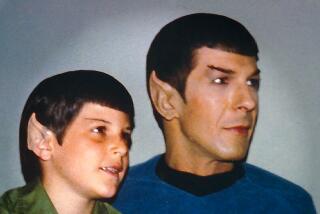An Enterprising ‘Star Trek’ Series Warps Back to TV
- Share via
One series and four movies later, the ol’ starship Enterprise has finally been re-commissioned and sent out into the galaxy, a new ship.
It revs up the warp engines of this old Trekkie’s heart.
The Enterprise in “Star Trek: The Next Generation” (seen locally on KCOP Channel 13) has once again returned to the little screen, where it all began in 1966, with a ship twice the size of the original (it now holds more than 1,000 people, including families--up from the 430 or so on the original). And this baby is no Titanic: she sails full-dilithium-crystals-ahead in grace and majesty.
According to both A.C. Nielsen and Channel 13, the show is doing exceptionally well in the ratings. Paramount already has renewed it for a second year.
The new show doesn’t give one a sense of deja vu, but more a feeling of fresh air (and paint, for that matter). Kirk, Spock and McCoy are gone, but we’re on familiar ground here, thank you very much. It’s as comfortable as a cat smiling in the sun.
“Star Trek: The Next Generation” features the same intelligent scripting, tension-creating scenes and wonderfully wry humor and camaraderie that were the hallmarks of the original.
In the old show, it wasn’t so much the toys, it was the tales. May my Spock ears melt and my Official Star Trek Fan Club membership get canceled if I believed for one minute that the old show was/is (it’s still in healthy syndication) a silly exercise in space opera. Its stories were adult and dealt with honor, environmental issues, political and moral ideas, the sense that no matter what you were--Denebian Slime Worm, Romulan or Klingon, two-armed or six-legged--intelligent, reasoning beings could find some basis for mutual understanding.
“Star Trek: The Next Generation” has so far amply addressed these same concerns.
Set 78 years beyond the original series, the show sports the fifth starship to be named Enterprise. Gone is the overall harsh lighting, the functional and sparsely furnished rooms and the furious blinking lights visible on every electronic board. The Enterprise now looks more like a cruise ship than a battle cruiser, with indirect lighting and a soft pastel color scheme.
There’s also a new wonder aboard ship, a veritable Disneyland of adventures for those in need of them: a “holodeck” that is programable for thousands of environments, down to the last fern and babbling brook.
Gene Roddenberry (creator and paterfamilias of the “Star Trek” universe in all its manifestations)wanted the current Enterprise to reflect less a military presence and more the fact that it was unreasonable to expect people to spend 15 years or more in space without any family life, or chance of it. So children, wives and lovers are an active part of the Enterprise environment.
Granted, the physical sets and costumes utilized in the original series, though terribly endearing in retrospect, had in some cases a lot to be desired in their kitschy and rather glitzy surfaces. But in those days budgets were more like $180,000 per episode and now it’s close to $1 million. And currently, they have George Lucas’ special effects company, Industrial Light & Magic, giving the new series the sleek look of the “Star Trek” feature films.
Although Roddenberry’s multiracial cast cut a lot of new ground in the ‘60s, and Uhura’s presence and rank on the old bridge was a big sign of progress, women guest stars were frequently exotic and/or erotic boy-toy elements in the plots, especially in relationship to Capt. Kirk. On the new show, more women are visible in areas of command. The chief medical officer is a woman (Dr. Beverly Crusher, played by Gates McFadden), as is the head security officer, Tasha Yar (Denise Crosby), an especially good casting against type. And in the episode “The Naked Now,” the chief engineer on duty was a woman.
Another nice touch with respect to gender in the new “Star Trek” is that it’s not just women who wear short skirts--men in the hallways have been spied in kilts.
The new characters are charming and growing right before our eyes, even awkward and rough-edged sometimes. The crew, as much as the audience is, are finding their emotional way among their several personalities.
Comdr. Data (Brent Spiner), the android, is proving a humorous mirror of human foibles and provides additional humor with his banter with Geordi Laforge (LeVar Burton), the blind navigator and Cmdr. William Riker (Jonathan Frakes). Wesley Crusher (Wil Wheaton), son of the doctor, is a growing teen-ager who presents an eager, puppy-like devotion to Starfleet. His unabashed sense of wonder with the new Enterprise and her crew reflects how a lot of us in the audience would feel if we were allowed to roam the halls.
Capt. Jean-Luc Picard (Patrick Stewart), with his elegant bearing, his Royal Shakespeare Company diction and his maturity, is a great addition, giving the show a commanding and solid center. He’s so much more deliberate than Capt. Kirk, and watching him slowly unbend with his crew (and children) has been enjoyable.
Spiner as the android, Michael Dorn as the Klingon named Worf and Marina Sirtis as the empathetic, half-human, half-Betazoid, provide the alien spice that always gave the Enterprise its decided edge over the competition.
One may be permitted to hope that the new “Star Trek,” like its predecessor, will “live long and prosper.”
More to Read
The complete guide to home viewing
Get Screen Gab for everything about the TV shows and streaming movies everyone’s talking about.
You may occasionally receive promotional content from the Los Angeles Times.






